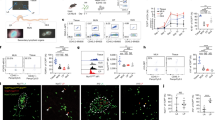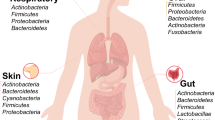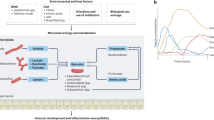Abstract
Inflammatory bowel disease can be caused by the dysfunction of the intestinal mucosal barrier and dysregulation of gut microbiota. Traditional treatments use drugs to manage inflammation with possible probiotic therapy as an adjuvant. However, current standard practices often suffer from metabolic instability, limited targeting and result in unsatisfactory therapeutic outcomes. Here we report on artificial-enzyme-modified Bifidobacterium longum probiotics for reshaping a healthy immune system in inflammatory bowel disease. Probiotics can promote the targeting and retention of the biocompatible artificial enzymes to persistently scavenge elevated reactive oxygen species and alleviate inflammatory factors. The reduced inflammation caused by artificial enzymes improves bacterial viability to rapidly reshape the intestinal barrier functions and restore the gut microbiota. The therapeutic effects are demonstrated in murine and canine models and show superior outcomes to traditional clinical drugs.
This is a preview of subscription content, access via your institution
Access options
Access Nature and 54 other Nature Portfolio journals
Get Nature+, our best-value online-access subscription
$29.99 / 30 days
cancel any time
Subscribe to this journal
Receive 12 print issues and online access
$259.00 per year
only $21.58 per issue
Buy this article
- Purchase on Springer Link
- Instant access to full article PDF
Prices may be subject to local taxes which are calculated during checkout






Similar content being viewed by others
References
Alatab, S. et al. The global, regional, and national burden of inflammatory bowel disease in 195 countries and territories, 1990–2017: a systematic analysis for the Global Burden of Disease Study 2017. Lancet Gastroenterol. Hepatol. 5, 17–30 (2020).
Hoivik, M. L. et al. Health-related quality of life in patients with ulcerative colitis after a 10-year disease course: results from the IBSEN study. Inflamm. Bowel Dis. 18, 1540–1549 (2012).
Citi, S. Intestinal barriers protect against disease. Science 359, 1097–1098 (2018).
Turner, J. R. Intestinal mucosal barrier function in health and disease. Nat. Rev. Immunol. 9, 799–809 (2009).
Chu, H. et al. Gene-microbiota interactions contribute to the pathogenesis of inflammatory bowel disease. Science 352, 1116–1120 (2016).
Lloyd-Price, J. et al. Multi-omics of the gut microbial ecosystem in inflammatory bowel diseases. Nature 569, 655–662 (2019).
Plichta, D. R., Graham, D. B., Subramanian, S. & Xavier, R. J. Therapeutic opportunities in inflammatory bowel disease: mechanistic dissection of host-microbiome relationships. Cell 178, 1041–1056 (2019).
Jostins, L. et al. Host–microbe interactions have shaped the genetic architecture of inflammatory bowel disease. Nature 491, 119–124 (2012).
Grisham, M. B. Oxidants and free radicals in inflammatory bowel disease. Lancet 344, 859–861 (1994).
Dickinson, B. C. & Chang, C. J. Chemistry and biology of reactive oxygen species in signaling or stress responses. Nat. Chem. Biol. 7, 504–511 (2011).
Lee, Y. et al. Hyaluronic acid–bilirubin nanomedicine for targeted modulation of dysregulated intestinal barrier microbiome and immune responses in colitis. Nat. Mater. 19, 118–126 (2020).
Scott, B. M. et al. Self-tunable engineered yeast probiotics for the treatment of inflammatory bowel disease. Nat. Med. 27, 1212–1222 (2021).
Bernstein, C. N. et al. World Gastroenterology Organization practice guidelines for the diagnosis and management of IBD in 2010. Inflamm. Bowel Dis. 16, 112–124 (2010).
Lautenschläger, C., Schmidt, C., Fischer, D. & Stallmach, A. Drug delivery strategies in the therapy of inflammatory bowel disease. Adv. Drug Deliv. Rev. 71, 58–76 (2014).
Cader, M. Z. & Kaser, A. Finding the right target for drug-resistant inflammatory bowel disease. Nat. Med. 27, 1870–1871 (2021).
Suez, J., Zmora, N., Segal, E. & Elinav, E. The pros, cons, and many unknowns of probiotics. Nat. Med. 25, 716–729 (2019).
Motta, J.-P. et al. Food-grade bacteria expressing elafin protect against inflammation and restore colon homeostasis. Sci. Transl. Med. 4, 158ra144–158ra144 (2012).
Brioukhanov, A. L. & Netrusov, A. I. Aerotolerance of strictly anaerobic microorganisms and factors of defense against oxidative stress: a review. Appl. Biochem. Microbiol. 43, 567–582 (2007).
McCord, J. M., Keele, B. B. Jr. & Fridovich, I. An enzyme-based theory of obligate anaerobiosis: the physiological function of superoxide dismutase. Proc. Natl Acad. Sci. USA 68, 1024–1027 (1971).
Imlay, J. A. How oxygen damages microbes: oxygen tolerance and obligate anaerobiosis. Adv. Microb. Physiol. 46, 111–153 (2002).
Tally, F. P., Goldin, B. R., Jacobus, N. V. & Gorbach, S. L. Superoxide dismutase in anaerobic bacteria of clinical significance. Infect. Immun. 16, 20–25 (1977).
Huang, Y., Ren, J. & Qu, X. Nanozymes: classification, catalytic mechanisms, activity regulation, and applications. Chem. Rev. 119, 4357–4412 (2019).
Jiao, L. et al. When nanozymes meet single-atom catalysis. Angew. Chem. Int. Ed. 59, 2565–2576 (2020).
Cao, F. et al. An enzyme-mimicking single-atom catalyst as an efficient multiple reactive oxygen and nitrogen species scavenger for sepsis management. Angew. Chem. Int. Ed. 32, 5108–5115 (2020).
Zhang, C. et al. Colonization and probiotic function of Bifidobacterium longum. J. Funct. Foods 53, 157–165 (2019).
Chen, Y. et al. Isolated single iron atoms anchored on N-doped porous carbon as an efficient electrocatalyst for the oxygen reduction reaction. Angew. Chem. Int. Ed. 56, 6937–6941 (2017).
Zhang, H. et al. Single atomic iron catalysts for oxygen reduction in acidic media: particle size control and thermal activation. J. Am. Chem. Soc. 139, 14143–14149 (2017).
Pan, Y. et al. Regulating the coordination structure of single-atom Fe-NxCy catalytic sites for benzene oxidation. Nat. Commun. 10, 4290 (2019).
Bull, S. D. et al. Exploiting the reversible covalent bonding of boronic acids: recognition, sensing, and assembly. Acc. Chem. Res. 46, 312–326 (2013).
Geng, W. et al. Click reaction for reversible encapsulation of single yeast cells. ACS Nano 13, 14459–14467 (2019).
Bron, P. A., van Baarlen, P. & Kleerebezem, M. Emerging molecular insights into the interaction between probiotics and the host intestinal mucosa. Nat. Rev. Microbiol. 10, 66–78 (2012).
Hua, S. Advances in oral drug delivery for regional targeting in the gastrointestinal tract-influence of physiological, pathophysiological and pharmaceutical factors. Front. Pharmacol. 11, 524 (2020).
Stillhart, C. et al. Impact of gastrointestinal physiology on drug absorption in special populations––an UNGAP review. Eur. J. Pharm. Sci. 147, 105280 (2020).
Pawar, V. K. et al. Gastroretentive dosage forms: a review with special emphasis on floating drug delivery systems. Drug Deliv. 18, 97–110 (2011).
Wirtz, S., Neufert, C., Weigmann, B. & Neurath, M. F. Chemically induced mouse models of intestinal inflammation. Nat. Protoc. 2, 541–546 (2007).
Liu, Y. et al. Integrated cascade nanozyme catalyzes in vivo ROS scavenging for anti-inflammatory therapy. Sci. Adv. 6, eabb2695 (2020).
Sokol, H. et al. Low counts of Faecalibacterium prausnitzii in colitis microbiota. Inflamm. Bowel Dis. 15, 1183–1189 (2009).
Morgan, X. C. et al. Dysfunction of the intestinal microbiome in inflammatory bowel disease and treatment. Genome Biol. 13, R79 (2012).
Manichanh, C. et al. Reduced diversity of faecal microbiota in Crohn’s disease revealed by a metagenomic approach. Gut 55, 205–211 (2006).
Wright, E. K. et al. Recent advances in characterizing the gastrointestinal microbiome in Crohn’s disease: a systematic review. Inflamm. Bowel Dis. 21, 1219–1228 (2015).
Shang, L. et al. Core altered microorganisms in colitis mouse model: a comprehensive time-point and fecal microbiota transplantation analysis. Antibiotics 10, 643 (2021).
Salem, F. et al. Gut microbiome in chronic rheumatic and inflammatory bowel diseases: similarities and differences. United Eur. Gastroenterol. J. 7, 1008–1032 (2019).
Baldelli, V., Scaldaferri, F., Putignani, L. & Del Chierico, F. The role of enterobacteriaceae in gut microbiota dysbiosis in inflammatory bowel diseases. Microorganisms 9, 697 (2021).
Castellarin, M. et al. Fusobacterium nucleatum infection is prevalent in human colorectal carcinoma. Genome Res. 22, 299–306 (2012).
Kostic, A. D. et al. Genomic analysis identifies association of Fusobacterium with colorectal carcinoma. Genome Res. 22, 292–298 (2012).
Ziegler, A., Gonzalez, L. & Blikslager, A. Large animal models: the key to translational discovery in digestive disease research. Cell. Mol. Gastroenterol. Hepatol. 2, 716–724 (2016).
National Institute of Diabetes and Digestive and Kidney Diseases. Opportunities and Challenges in Digestive Diseases Research: Recommendations of the National Commission on Digestive Diseases. NIH Publication No. 08–6514 (National Institutes of Health, 2009).
Chandra, L. et al. Derivation of adult canine intestinal organoids for translational research in gastroenterology. BMC Biol. 17, 33 (2019).
Schaefer, K., Rensing, S., Hillen, H., Burkhardt, J. E. & Germann, P. G. Is science the only driver in species selection? An internal study to evaluate compound requirements in the minipig compared to the dog in preclinical studies. Toxicol. Pathol. 44, 474–479 (2016).
Mehrabani, D. et al. The healing effect of Teucrium polium in acetic acid-induced ulcerative colitis in the dog as an animal model. Middle East J. Dig. Dis. 4, 40–47 (2012).
Ballal, S. A. et al. Host lysozyme-mediated lysis of Lactococcus lactis facilitates delivery of colitis-attenuating superoxide dismutase to inflamed colons. Proc. Natl Acad. Sci. USA 112, 7803–7808 (2015).
Han, W. et al. Improvement of an experimental colitis in rats by lactic acid bacteria producing superoxide dismutase. Inflamm. Bowel Dis. 12, 1044–1052 (2006).
de Moreno de LeBlanc, A. et al. Oral administration of a catalase-producing Lactococcus lactis can prevent a chemically induced colon cancer in mice. J. Med. Microbiol. 57, 100–105 (2008).
Liu, M. et al. Oral engineered Bifidobacterium longum expressing rhMnSOD to suppress experimental colitis. Int. Immunopharmacol. 57, 25–32 (2018).
LeBlanc, J. G. et al. Use of superoxide dismutase and catalase producing lactic acid bacteria in TNBS induced Crohn’s disease in mice. J. Biotechnol. 151, 287–293 (2011).
Zhao, S. et al. An orally administered CeO2@montmorillonite nanozyme targets inflammation for inflammatory bowel disease therapy. Adv. Funct. Mater. 30, 2004692 (2020).
Cheng, C., Zhao, S., Cheng, Y., Liu, Y. & Wei, H. Design of nanozymes for inflammatory bowel disease therapy. Sci. China Life Sci. 64, 1368–1371 (2021).
Wei, H. & Wang, E. Nanomaterials with enzyme-like characteristics (nanozymes): next-generation artificial enzymes. Chem. Soc. Rev. 42, 6060–6093 (2013).
Cheng, C. et al. Multifunctional nanozyme hydrogel with mucosal healing activity for single-dose ulcerative colitis therapy. Bioconjugate Chem. 33, 248–259 (2022).
Lin, S. et al. Mucosal immunity-mediated modulation of the gut microbiome by oral delivery of probiotics into Peyer’s patches. Sci. Adv. 7, eabf0677 (2021).
Anselmo, A. C., McHugh, K. J., Webster, J., Langer, R. & Jaklenec, A. Layer-by-layer encapsulation of probiotics for delivery to the microbiome. Adv. Mater. 28, 9486–9490 (2016).
Zheng, D. W. et al. Prebiotics‐encapsulated probiotic spores regulate gut microbiota and suppress colon cancer. Adv. Mater. 32, 2004529 (2020).
Centurion, F. et al. Nanoencapsulation for probiotic delivery. ACS Nano 15, 18653–18660 (2021).
Acknowledgements
This work was supported by the National Natural Science Foundation of China (grant nos. 52273152, 51822306 and 22161132027 to Z.M.), Science Technology Department of Zhejiang Province (grant no. 2021C03121 to W.W. and Z.M.), Starry Night Science Fund of Zhejiang University Shanghai Institute for Advanced Study (grant no. SN-ZJU-SIAS-006 to Z.M.), Zhejiang High-Level Young Talent Special Support Plan (Z.M.), the National University of Singapore Start-Up Grant (NUHSRO/2020/133/Startup/08 to X.C.), NUS School of Medicine Nanomedicine Translational Research Programme (NUHSRO/2021/034/TRP/09/Nanomedicine to X.C.) and the Lee Foundation Microbiome Education Grant (X.C.). We cordially thank Q. He from the School of Chemical and Biological Engineering at Zhejiang University and L. Zheng from Beijing Synchrotron Radiation Facility, Institute of High Energy Physics, Chinese Academy of Sciences, for their support in the X-ray absorption spectroscopy measurements and analyses.
Author information
Authors and Affiliations
Contributions
Z.M., X.C., W.W. and F.C. conceived the study, designed the experiments and wrote the manuscript. F.C., L.J. and Y.G. prepared and characterized the platform. F.C. and Y.G. investigated the ROS-scavenging ability. F.C. and L.J. evaluated the bacterial experiments. F.C. and H.W. carried out the in vitro experiments. F.C., Z.Q., C.Z., Y.G. and J.Z. conducted the in vivo experiments on mice. F.C., Y.D., Z.Q., C.Z., Y.G., L.H., H.Y. and Z.T. conducted the in vivo experiments on dogs. All the authors reviewed the manuscript.
Corresponding authors
Ethics declarations
Competing interests
X.C., Z.M. and F.C. are inventors on a patent application (international patent application no. PCT/CN2021/116214) based on the technology presented in this manuscript. All other authors declare no competing interests.
Peer review
Peer review information
Nature Nanotechnology thanks Alejandra De Moreno de LeBlanc, Kam Leong, Hui Wei and the other, anonymous, reviewer(s) for their contribution to the peer review of this work.
Additional information
Publisher’s note Springer Nature remains neutral with regard to jurisdictional claims in published maps and institutional affiliations.
Extended data
Extended Data Fig. 1 Comparison of UC therapy between BL@B-SA50 and clinical therapy.
(a) C57BL/6 mice were provided with water or 3% DSS-containing water for 4 days. On days 4, 5, 6 and 7, mice were orally administered with Medium, 5-ASA (30 mg kg–1), DEX (1 mg/kg), MPS (1 mg/kg) or BL@B-SA50 (BL: 2.5 × 108 CFU kg–1, B-SA: 1.25 mg/kg). (b) Daily body weight changes in each group for 9 days. Data were normalized as a percentage of the body weight at day 0. (c) Changes in DAI. (d) Lengths and (e) pictures of mice colon with indicated treatments on day 8. (f) C57BL/6 mice were provided with water or 3% DSS-containing water for 4 days. On days 4, 5, 6 and 7, mice were orally administered with Medium, BL (2.5 × 108 CFU/kg) + 5-ASA (30 mg/kg), BL (2.5 × 108 CFU/kg) + DEX (1 mg/kg), BL (2.5 × 108 CFU/kg) + MPS (1 mg/kg) or BL@B-SA50 (BL: 2.5 × 108 CFU/kg, B-SA: 1.25 mg/kg). (g) Daily body weight changes in each group for 9 days. Data were normalized as a percentage of the body weight at day 0. (h) Changes in DAI. (i) Lengths and (j) pictures of mice colon with indicated treatments on day 8. Data are presented as mean ± s. d. from n = 5 biological replicates. Statistical analysis was calculated by unpaired Student’s two-sided t test. 1P, 2P, 3P, 4P and 5P, in (b, c) denote the statistical significance of Health, BL@B-SA50, MPS, DEX and 5-ASA group relative to the Control group, while in (g, h) denotes the statistical significance of Health, BL@B-SA50, BL + MPS, BL + DEX and BL + 5-ASA group relative to the Control group, respectively. P in (d, i) denotes the statistical significance relative to the Control group. #P in (d, i) denotes the statistical significance of BL@B-SA50 relative to the Health group.
Extended Data Fig. 2 CD therapy with BL@B-SA50.
(a) C57BL/6 mice were pre-sensitized by absorption of TNBS solution through the skin. After one week, TNBS solutions were slowly administered into the colon lumen of mice to induce CD. Then, mice were orally administered with Medium or B-SA (1.25 mg/kg), BL (2.5 × 108 CFU/kg), BL (2.5 × 108 CFU kg−1) + B-SA (1.25 mg/kg), BL@B-SA50 (BL: 2.5 × 108 CFU/kg, B-SA: 1.25 mg/kg) for four days. (b) Daily bodyweight development after administering TNBS solution into the colon lumen. Data were normalized as a percentage of the bodyweight at day 8. (c) Changes in DAI. (d) Lengths and (e) picture of mice colon with indicated treatments on day 13. Data are presented as mean ± s. d. from n = 5 biological replicates. Statistical analysis was calculated by unpaired Student’s two-sided t test. 1P, 2P, 3P, 4P and 5P, in (b, c) denotes the statistical significance of Health, BL@B-SA50, BL + B-SA, BL and B-SA group relative to the Control group, respectively. P in (d) denotes the statistical significance relative to the Control group. #P in (d) denotes the statistical significance of BL@B-SA50 relative to the Health group.
Supplementary information
Supplementary Information
Supplementary Figs. 1–38, Table 1 and methods.
Supplementary Data 1
Supplementary source data.
Source data
Source Data Fig. 1
Statistical source data.
Source Data Fig. 2
Statistical source data.
Source Data Fig. 3
Statistical source data.
Source Data Fig. 4
Statistical source data.
Source Data Fig. 5
Statistical source data.
Source Data Fig. 6
Statistical source data.
Rights and permissions
Springer Nature or its licensor (e.g. a society or other partner) holds exclusive rights to this article under a publishing agreement with the author(s) or other rightsholder(s); author self-archiving of the accepted manuscript version of this article is solely governed by the terms of such publishing agreement and applicable law.
About this article
Cite this article
Cao, F., Jin, L., Gao, Y. et al. Artificial-enzymes-armed Bifidobacterium longum probiotics for alleviating intestinal inflammation and microbiota dysbiosis. Nat. Nanotechnol. 18, 617–627 (2023). https://doi.org/10.1038/s41565-023-01346-x
Received:
Accepted:
Published:
Issue Date:
DOI: https://doi.org/10.1038/s41565-023-01346-x
This article is cited by
-
Microbiota–gut–brain axis and its therapeutic applications in neurodegenerative diseases
Signal Transduction and Targeted Therapy (2024)



